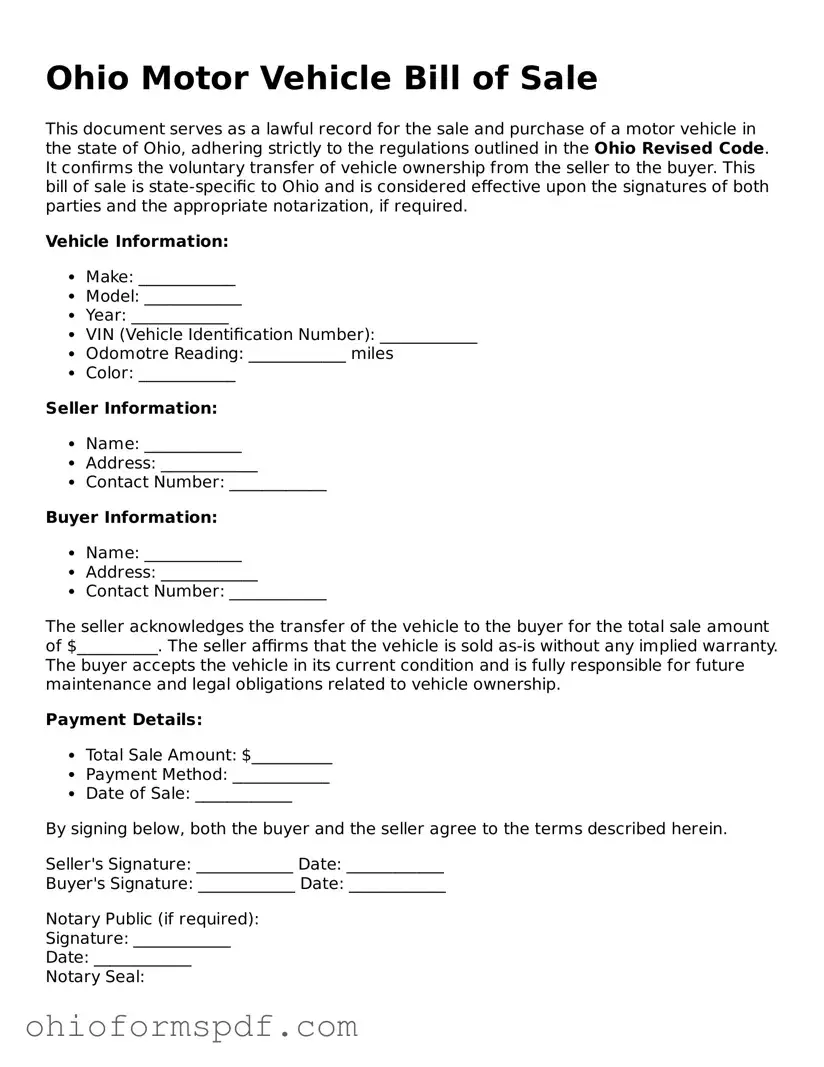What is an Ohio Motor Vehicle Bill of Sale?
An Ohio Motor Vehicle Bill of Sale is a legal document that records the sale of a motor vehicle between a seller and a buyer in the state of Ohio. It includes essential details such as the make, model, year, VIN (Vehicle Identification Number), the sale price, and the names and signatures of both parties involved. This document serves as proof of purchase and can be used for the legal transfer of ownership.
Is an Ohio Motor Vehicle Bill of Sale required for the sale of a vehicle?
While Ohio law does not mandate a bill of sale for private party vehicle transactions, it is highly recommended to create one. A bill of sale provides legal protection and serves as a record of the transfer of ownership. It may also be required by the Ohio Bureau of Motor Vehicles (BMV) for registration and titling purposes.
What information needs to be included in an Ohio Motor Vehicle Bill of Sale?
An Ohio Motor Vehicle Bill of Sale should include the date of the sale, the purchase price, and detailed information about the vehicle such as its make, model, year, VIN, and odometer reading at the time of sale. It should also contain the printed names, signatures, and addresses of both the seller and the buyer. Including a statement about the vehicle's warranty status (sold as-is or with warranty) is also advisable.
Do both the buyer and the seller need to sign the Ohio Motor Vehicle Bill of Sale?
Yes, both the buyer and the seller must sign the Ohio Motor Vehicle Bill of Sale for it to be valid. The signatures serve as an acknowledgment from both parties that the information recorded in the document is accurate and that the transaction has legally taken place.
Does an Ohio Motor Vehicle Bill of Sale need to be notarized?
No, an Ohio Motor Vehicle Bill of Sale does not need to be notarized. However, getting it notarized can add an extra layer of legality and may help protect both parties in the event of a dispute. While not a requirement, it is an option worth considering.
How does an Ohio Motor Vehicle Bill of Sale protect the buyer?
An Ohio Motor Vehicle Bill of Sale protects the buyer by providing a document that confirms the vehicle's condition, the sale price, and the transfer of ownership from the seller. This can be invaluable in disputes or if the legality of the sale is questioned. Additionally, it assists in the vehicle registration and titling process.
How does an Ohio Motor Vehicle Bill of Sale protect the seller?
For the seller, an Ohio Motor Vehicle Bill of Sale serves as proof that the vehicle has been legally transferred to another individual, releasing them from liability associated with the vehicle's future use or misuse. It also ensures that the agreed upon terms of the sale are documented, which can help in preventing future disputes.
Can an Ohio Motor Vehicle Bill of Sale be used for registering a vehicle?
Yes, an Ohio Motor Vehicle Bill of Sale can be used as part of the documentation required for registering a vehicle in Ohio. While it may not be the only document required by the Ohio BMV, it serves as a crucial piece of evidence showing the change of ownership.
What should I do if I lose my Ohio Motor Vehicle Bill of Sale?
If you lose your Ohio Motor Vehicle Bill of Sale, it is advisable to contact the other party involved in the transaction and request a copy. If that is not possible, drafting a new bill of sale to be signed again can serve as a substitute. Keeping digital copies can prevent such issues in the future.
Are there any specific formatting requirements for an Ohio Motor Vehicle Bill of Sale?
While there are no strict formatting requirements for an Ohio Motor Vehicle Bill of Sale, it should be clear, concise, and contain all necessary information regarding the sale and the vehicle. Using a template designed for Ohio or a generic vehicle bill of sale template that includes all required details is recommended to ensure all pertinent information is covered.
